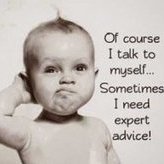I want to share a technique that can help you to choose your desired winning frequency before you enter into a trade. I would guess a larger number of retail traders don't lose because they are wrong but because they use stops improperly and lose money even when they're right.
Assume for these purposes that the market is mostly random, if true then that means that an X point move up or down has little value in determining what the market will do next because, of course, if it did have value then we could use that predict it. Now, it is true that I predict the market but I will agree that the market is mostly random to most people most of the time. This implies we can determine our win frequency before entering a trade simply by choosing a stop and target of the appropriate size. The expected profit must be zero.
The formula is:
WIN AMOUNT * WIN FREQUENCY – LOSS AMOUNT * LOSS FREQUENCY = 0
Examples:
+5 and -5 point target and stop will win 50% by random chance
+5 and -15 point target and stop will win 75% by random chance
+5 and -20 point target and stop will win 80% by random chance
Formula examples:
5*W-5*(1-W) = 0
5W – 5 + 5W = 0
10W = 5, W = ½, W = .5
5*W-20(1-W) =0
5W -20 + 20W =0
25W = 20
W = 20/25 = .8
If these are challenging, you can use the equation solver at
http://www.algebrahelp.com/calculators/equation/
You can choose any winning ratio that you desire using this method. I personally would feel quite comfortable with 65% to 80% win ratio. Of course, your profit expectation is still going to be zero unless you have an edge. My point is that many people may have a slight 2% to 5% edge but ruin it with poor stops. It is very easy to erode such a small edge with a poor stop. The goal is to use the mathematics of randomness to prevent that. While the expectation is the true measure of a system, if one chooses a system with a very low win rate then by random chance they could experience a very long streak of losers. Psychologically this will be difficult for many to work through. I have, also found that when win rates drop below around 55% that the resultant equity curves become rather unstable.
It is worth to consider the assumptions in which choosing a higher win rate would work better then not. If our model is such that we can predict that the market will move in a given direction more times then not then choosing a higher win rate should be beneficial. However, if our ability is more about predicting the larger movements then we may want to choose a lower risk and a higher reward payoff.
This is an updated authorized partial excerpt from My Favorite Edges Bonus. Chapter "Choose Your Win Rate".
----
Curtis

